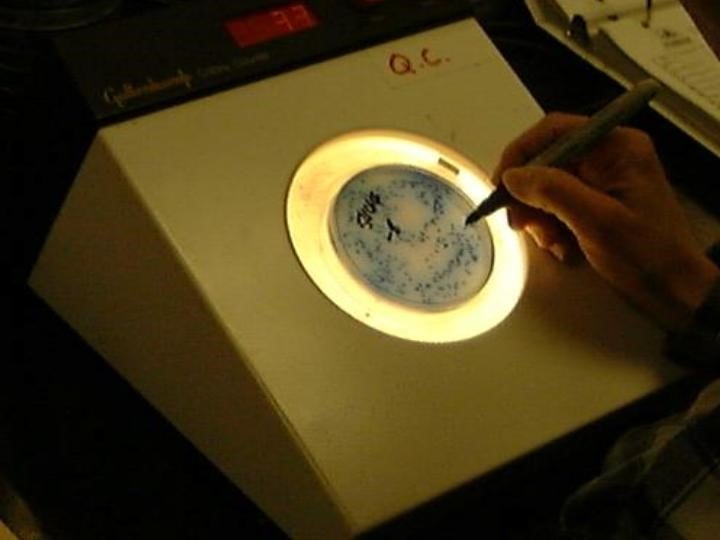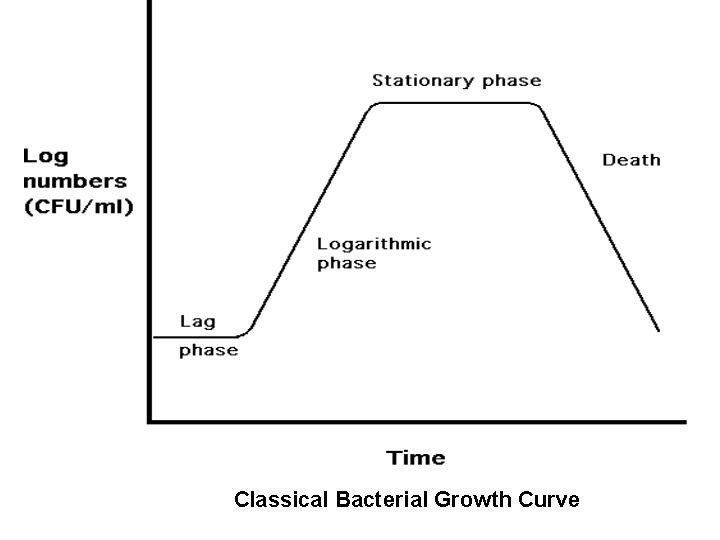Understanding Inoculant Bacterial Counts
BackReading bacterial counts on bacterial inoculant product labels
 Bacterial populations are enumerated by “colony forming units” or what’s more typically shown on product labels as “CFU”.
Bacterial populations are enumerated by “colony forming units” or what’s more typically shown on product labels as “CFU”.
Basically, the term describes the number of bacterial colonies a microbiologist counts on a pre-defined area on a culture plate as shown in the image at the right. CFU population counts usually are reported on a per gram basis (cfu/gm), although some competing inoculant product labels will list cfu on a per pound basis (cfu/lb).
Be sure to compare “apples with apples” when comparing labeled cfu counts of various products. For instance, remember that 454 grams equals 1 pound. Pioneer brand 1132 Inoculant has a “guaranteed total viable lactic acid-producing bacterial count” of 125 billion cfu/gm product.
A competing product might list 1.0 trillion cfu/lb. and lead the prospective customer to believe they are getting a deal based on bacterial counts. In reality, 1.0 trillion cfu/lb divided by 454 gram/lb calculates out to 2.2 billion cfu/gm. In this example, fewer bacteria are present in the competitor’s product than Pioneer’s.
Understanding logarithms used in bacterial inoculant product labels
The use of logarithms provides microbiologists with a method to easily indicate cfu/gm or cfu/lb without having to write out the number in typical numerical form. Logarithms (logs) work on a base 10 method so that the number 10 = log 1, 100 = log 2, 1,000 = log 3, etc. Logs are written in the following fashion: 10n; for example a log 3 would be 103. An absolute number is found in front of the log number.
For example 3,000,000,000 cfu/gm would be expressed as 3.0 X 109 where the absolute number is “3” and the log is that number of “0s” to the right of the decimal point. The label on Pioneer 1132 Inoculant reads 1.25 X 1011 cfu/gm product, which is the same as 125,000,000,000.
Classical bacterial growth curve during the ensiling process
 Bacteria follow a similar logarithmic growth pattern during the ensiling process as shown by the Classical Bacterial Growth Rate Curve illustration.
Bacteria follow a similar logarithmic growth pattern during the ensiling process as shown by the Classical Bacterial Growth Rate Curve illustration.
Bacterial growth starts out with minimal activity, followed by a fast logarithmic growth phase. The curve exponentially plateaus out into a stationary phase due to the bacteria creating its low pH environment.
Bacteria cfu counts then start to decline over time; some bacterial growth declines occur faster than others. How fast bacterial cfu populations multiply is dependant on several variables such as type of crop, substrate, temperature, and silage management practices.
For instance, a Lactobacillus plantarum strain could require 3 to 7 days in silage to move from “lag phase” to “stationary phase”.
This is dependant not only the variables listed above but also the particular strain. The cfu/gm forage log value for a Pioneer bacterial strain starts at 100,000 (105) and becomes “stationary” near 1 billion (109) cfu/gm forage.
Bacterial inoculant application goal: 100,000 cfu/gm forage and 10,000 cfu/gm HMC
Early silage inoculant research from Europe determined that a bacterial inoculant should to be applied at a level to achieve 100,000 (105) cfu/gm forage and is the application dosage for all forages treated with Pioneer’s bacterial strains.
Forage Additive researchers discovered prior to the introduction of 1186 that less than optimal fermentation performance resulted when HMC was applied at the 100,000 cfu/gm rate for HMC. After researching various dosage levels, the researchers determined that applying Pioneer’s bacterial strains at 10,000 cfu/gm was more effective for HMC. The packaging of the various crop specific inoculant products from Pioneer has different guaranteed cfu/gm counts.
You can be assured that Pioneer has formulated products at these levels to insure the delivery of the optimum dosage to your forage.
Competing companies may claim their product is superior because their product results in 400,000 cfu/gm forage while Pioneer’s is only at 100,000. The misleading part of this statement is that drastic differences exist in the ability of bacterial strains to DOMINATE fermentation.
Bacterial strains in the silo will multiply until they achieve a cfu/gm population of 1 billion and seldom exceed that population count. Pioneer Forage Additive researchers perform thousands of repetitive experiments to discover which Pioneer bacterial strains are able to DOMINATE fermentation and at what dosage level they most effectively can DOMINATE fermentation.
Director of Quality Control in Pioneer’s Forage Additive Research group Dr Scott Dennis said, “What the other companies use is irrelevant, it’s what our research has shown to be the most efficacious for Pioneer strains that determines the cfu/gm that Pioneer products should be applied to forages and HMC.”
Don’t fall into the CFU count trap
Inoculant competitors often sell their product based on cfu/gm population counts that greatly exceed what is found in Pioneer Inoculant. Those companies selling customers inoculant based on cfu counts usually fail to have background research demonstrating the ability of the product to:
- promote efficient fermentation and decrease shrink
- enhance digestion, protein quality and feeding efficiencies for improved dairy and beef performance, and
- improve bunklife properties at feedout.
The research behind the unique and patented combinations of Pioneer’s bacterial strains used to develop Pioneer’s crop specific inoculant products are what determine the value of Pioneer brand Inoculants.
IN0623-04A
Your seed is backed by
local experience
With dedicated and highly skilled team members located throughout Australia you can be sure of accessing the best local knowledge to help you maximise your investment in Pioneer® brand hybrid seed. Get in touch with your local Territory Sales Manager or Farm Services Consultant today.
